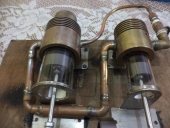I love the window farm idea, and designed a patio system to play with the idea. Just a heads up, those who are concerned about plastic containers are really going to hate my design. I obviously don't share the same concerns, and your opinions have been noted, but not adopted.

I selected laundry soap bottles for several reasons,
1) They are opaque so they block the sun from the roots.
2) Robust plastic compared to water bottles.
3) Large thread surface area on cap threads, flange on some of the caps, making a much stronger fastener connection.
4) Larger body to put more plants in each bottle.
5) Gather free from laundromats.
Filling the plastic bucket, 3/4 full of gravel, and a little growing media on top, gives more planting area.
System is super simple, and can be moved (I have a little hand truck just the right size).














